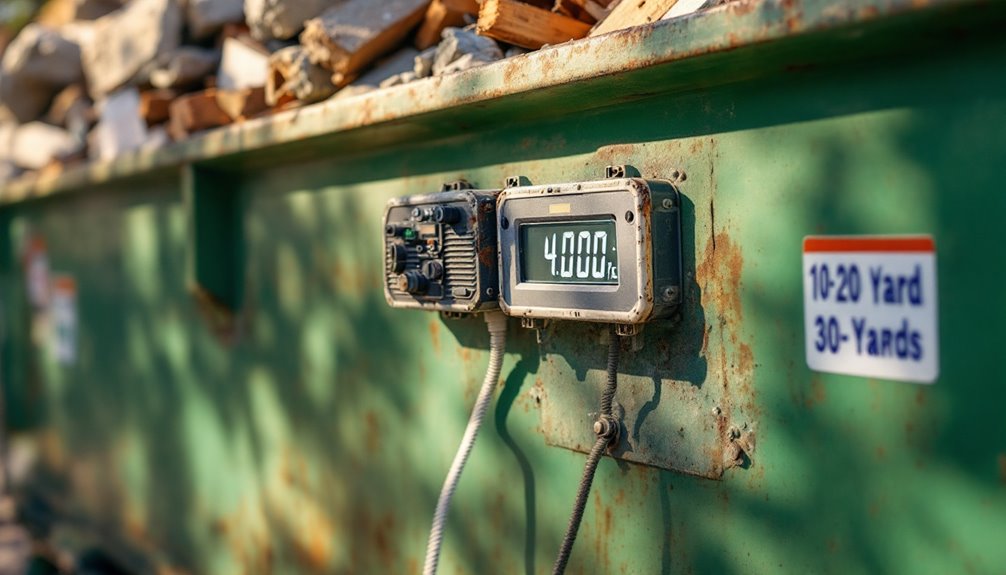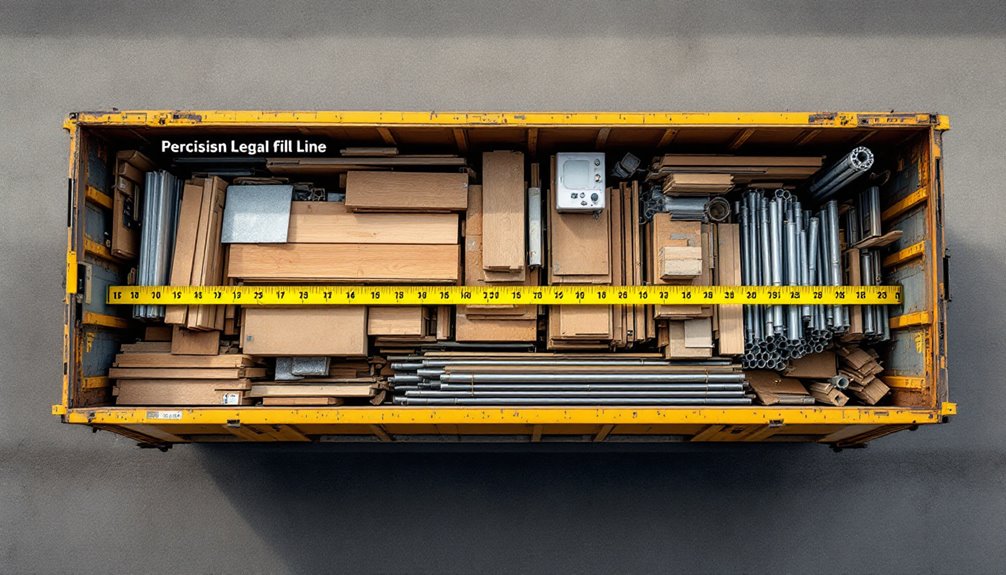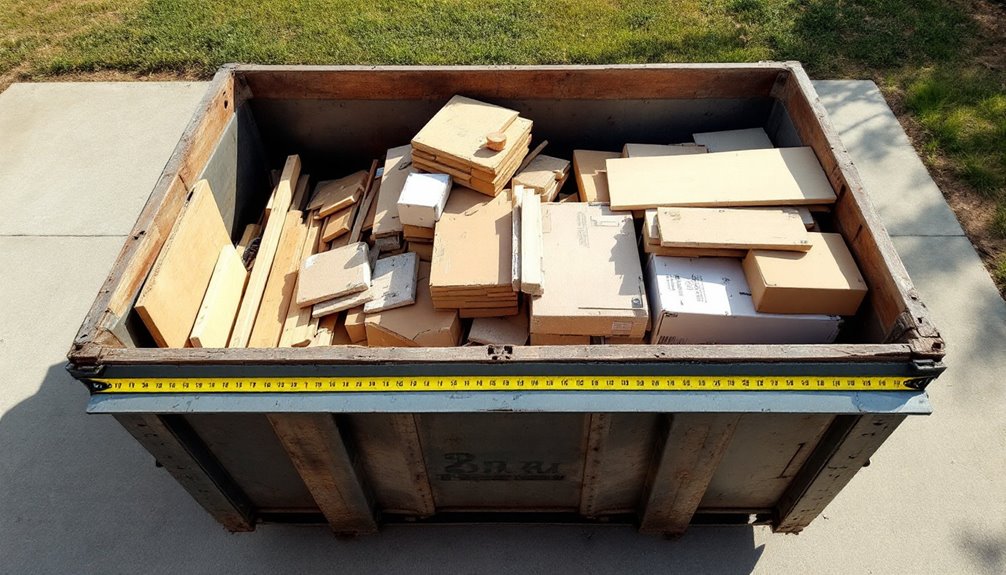You’ll find weight limits vary based on dumpster size, with 10-yard containers holding 2-3 tons and 40-yard options supporting up to 6-8 tons. Local regulations and material types affect these limits – concrete and dirt weigh more than cardboard or carpet. To avoid fees, you’ll need to distribute weight evenly and stay within capacity. Understanding your specific project needs and rental company restrictions will help you choose the right container.
Key Takeaways
- Weight limits vary by dumpster size: 10-yard holds 2-3 tons, 20-yard holds 2.5-3.5 tons, 30-yard holds 4.5-5 tons, and 40-yard holds 6-8 tons.
- Local road regulations and rental company policies determine maximum weight limits, typically ranging from 1-6 tons in urban areas.
- Heavy materials like concrete and dirt require special consideration, as they quickly reach weight limits due to density.
- Distribute weight evenly throughout the dumpster, placing heavier items at the bottom to maintain safety during transport.
- Exceeding weight limits results in additional fees and may require multiple trips or a larger dumpster rental.
Dumpster Weight Limits by Size

When choosing a dumpster rental, understanding weight limits for different sizes is essential for both safety and cost management. You’ll find that 10-yard dumpsters can handle 2-3 tons, making them perfect for your small clean-up projects.
If you’re tackling medium-sized work, 20-yard dumpsters accommodate 2.5-3.5 tons and offer more volume for household junk or construction debris. The truck hoist capacity and company policies determine the weight limits. With walk-in access available, loading materials becomes much more efficient and safer.
For bigger projects, you can count on 30-yard dumpsters to manage 4.5-5 tons, ideal when you’re doing a complete house cleanout. The largest option, 40-yard dumpsters, supports 6-8 tons and works best for major commercial or renovation projects. Remember, exceeding these limits isn’t just about extra fees—it’s about keeping your project safe and efficient. You’ll want to stay within these guidelines to avoid any hauling complications.
| Dumpster Size | Weight Limit | Ideal Materials |
| 10 Yard | 1-2 tons | Household debris, yard waste |
| 15 Yard | 2-3 tons | Mixed waste, small renovations |
| 20 Yard | 3-4 tons | Construction debris, roofing |
| 30 Yard | 5-6 tons | Large renovations, heavy debris |
| 40 Yard | 8-10 tons | Major construction, demolition |
Common Materials and Their Weight Impact
Understanding material weights is essential for successful dumpster rentals, as different items can swiftly consume your weight allowance. You’ll want to be particularly cautious with heavy construction materials like concrete, which weighs 4,000 pounds per cubic yard, and asphalt at 3,400 pounds per cubic yard.
Common renovation materials vary considerably in weight. While cardboard is relatively light at 30 pounds per cubic yard, materials like carpeting can weigh up to 4,000 pounds for 3,500 square feet. When disposing of yard waste, remember that loose dirt weighs about 2,500 pounds per cubic yard, while brush and limbs are much lighter at 250 pounds per cubic yard. For roofing projects, asphalt shingles are particularly heavy, with just 3.7 square feet weighing 1,000 pounds.
Transportation and Safety Requirements

Safe dumpster transportation depends heavily on understanding weight capacities and following strict safety protocols. When you rent a dumpster, you’ll need to take into account that most trucks can haul up to 10 tons, but local road restrictions often limit this to 1-6 tons for safety reasons.
You’ll want to distribute materials evenly in your dumpster to prevent shifting during transport. Remember that your rental company will weigh your dumpster before pickup and after delivery to verify compliance with weight limits.
If you exceed these limits, you may face additional fees or penalties. To protect yourself and others, never overfill your dumpster or exceed the specified weight capacity. This helps guarantee safe transportation and prevents damage to equipment while keeping everyone on the road safe.
Local Regulations and Weight Restrictions
Local regulations and weight restrictions vary extensively across different municipalities, directly impacting how you’ll use your dumpster rental. You’ll need to understand your area’s specific requirements to avoid penalties and guarantee compliance with local standards.
Consider these pivotal factors when loading your dumpster:
- Size matters – larger dumpsters typically allow for higher weight limits, but you’ll still need to follow local restrictions
- Material density affects capacity – heavy items like concrete require special consideration and often have stricter limits
- Location impacts rules – urban areas usually enforce stricter weight limits than rural locations due to infrastructure concerns
Avoiding Overage Fees and Penalties

To steer clear of costly penalties, you’ll need to develop a solid strategy for managing your dumpster’s weight limits and capacity restrictions. Start by confirming the exact weight allowance with your rental provider and selecting the right size container for your project needs.
Stay ahead of potential fees by monitoring your load as you fill the dumpster. Place heavier materials at the bottom and distribute weight evenly throughout the container. If you notice you’re approaching the weight limit, consider scheduling an early pickup to avoid overages. Remember, exceeding the limit isn’t just about the extra charges – it’s also about safety and compliance with local regulations.
Keep track of what you’re disposing of, and don’t fill above the container’s sides. Most rental companies charge by the ton for excess weight, so careful planning will protect your budget.
Frequently Asked Questions
Can I Mix Different Types of Waste Materials in the Same Dumpster?
You can mix different waste materials, but you’ll need to check with your rental company first since some materials shouldn’t be combined and certain hazardous items aren’t allowed.
How Do Weather Conditions Affect the Maximum Weight Capacity of Dumpsters?
You’ll need to account for rain and snow adding extra weight to your materials. High humidity can also increase weight through moisture absorption, affecting your dumpster’s maximum capacity.
What Happens if My Dumpster Sinks Into My Driveway?
If your dumpster sinks into your driveway, you’ll need to contact your rental company immediately. They can help assess the damage, reposition the container, and provide guidance on preventing future issues.
Can I Share a Dumpster Rental With My Neighbors?
You can share a dumpster with your neighbors to save money and build community. Just coordinate the size, costs, and usage rules together before starting your collective cleanup project.
Do Rental Companies Provide Scales or Weight Measurement Tools?
Most rental companies don’t provide scales, but you’ll find some offer on-site weight monitoring systems. You can also use truck scales at local waste facilities for accurate measurements.
Conclusion
You’ll need to respect your dumpster’s weight limits to avoid hefty overage fees and safety hazards. Remember that different sizes have different capacities, typically ranging from 1-3 tons for smaller units to 6-10 tons for larger ones. Check with your rental company about specific weight restrictions and distribute materials evenly. It’s better to rent a larger dumpster than risk overloading a smaller one.